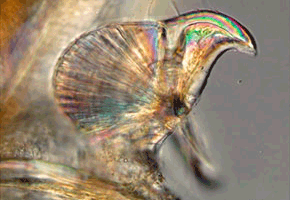

A study conducted at the CEBIMAR Marine Biology Center is published in PLoS One and describes new invertebrate species along the Brazilian coast
A study conducted at the CEBIMAR Marine Biology Center is published in PLoS One and describes new invertebrate species along the Brazilian coast
A study conducted at the CEBIMAR Marine Biology Center is published in PLoS One and describes new invertebrate species along the Brazilian coast

A study conducted at the CEBIMAR Marine Biology Center is published in PLoS One and describes new invertebrate species along the Brazilian coast
By Fábio de Castro
Agência FAPESP – A study conducted by researchers at the Universidade de São Paulo’s Marine Biology Center (Centro de Biologia Marinha, CEBIMAR/USP) resulted in the description of nine new bryozoan species of the Bugula genus along the Brazilian coast. Bryozoans are mostly marine invertebrates that live in colonies fixed to a substrate.
The study describing the species, which were found along the coastlines of the states of São Paulo, Rio de Janeiro and Espírito Santo, was published in the journal PLoS One.
The new species were named Bugula bowiei, Bugula foliolatan, Bugula guara, Bugula biota, Bugula ingens, Bugula gnoma, Bugula alba, Bugula rochae and Bugula migottoi.
The names of the new species pay homage to the BIOTA-FAPESP Program (Bugula biota), the vice director of CEBIMAR Álvaro Migotto (Bugula migottoi), professor Rosana Rocha of the Universidade Federal do Paraná Zoology Department (Bugula rochae), and British musician David Bowie (Bugula bowiei).
The article describing the new species was written by Leandro Vieira, a researcher in the Zoology Department at the USP Biosciences Institute (IB), Karin Fehlauer-Ale, a researcher in the CEBIMAR Laboratory of Bryozoa Systematics and Evolution, and Judith Winston from the Judith Winston Virginia Museum of Natural History in the United States.
The study was funded by FAPESP as part of the project titled “Molecular characterization of Bugula spp. (Bryozoa, Cheilostomata, Bugulidae): implications on taxonomy, phylogeny and bioinvasion,” which was coordinated by Migotto.
According to Fehlauer-Ale, in addition to contributing to the morphological characterization and knowledge of the abundance of species in the Bugula genus in the South Atlantic, the study also involved a taxonomic revision of this genus.
Some of the new species characterized had previously been confused with species that are typical of the North Atlantic and were considered to be invasive species in Brazil.
“In some cases, it was not an invasive species but rather a taxonomic problem. It is important to revise in this way because the incorrect identification of a taxon can result in inappropriate measures against invasive species that, in fact, are not invasive or could underestimate the diversity of a coastline by considering many species as a single one,” Fehlauer-Ale told Agência FAPESP.
Even though bryozoans are sessile organisms—meaning that their lives are spent attached to a marine substrate—these organisms move within the water column during the larval stage of their life cycle. However, because their mobile stage is very short, it is plausible that each species has a certain geographical restriction.
“Contrary to what one would expect, we have observed that many species are globally distributed. The hypothesis that we suggested to explain this is anthropogenic transport: during their adult phase, bryozoans could be disseminated on the hulls of ships. This is why there is a concern about invasive species from this phylum,” said Fehlauer-Ale.
Sixty percent of known species
One of the objectives of the CEBIMAR group was to understand better which species live along the Brazilian coast. The Bugula genus was chosen because it already included some species known to be invasive. Another objective was to collect comparative samples from areas outside the main study area (the Southeast). Thus, the group studied the coastal regions in Alagoas, Espírito Santo, Rio de Janeiro, São Paulo and Paraná.
“To our surprise, we discovered nine new species, which represent over 60% of the species already known along the Brazilian coast,” said Fehlauer-Ale.
In addition to the article’s authors, the study received contributions from Andrea Waeschenbach of the Natural History Museum in London and Ezequiel Ale, a doctoral candidate in genetics and evolutionary biology at IB-USP.
Fehlauer-Ale says that from now on, her studies will be focused on the species Bugula neritina, and there is evidence that the species is a “mosaic.” “It is possible that there are three morphologically similar species of Bugula that show differences by DNA analyses and other characteristics, such as bacterial symbiosis. Found on a global scale, two of the species have the potential to be invasive,” she affirmed.
Also collaborating on the project will be researchers Joshua Mackie from San Jose State University in California and Grace Lin-Fong from Randolph-Macon College in Virginia, both in the United States.
Winston received FAPESP funding for the study through its Visiting Researcher Support program as a part of the study titled “Systematics, evolution and distribution of extant marine bryozoans in Brazil,” which is also coordinated by Migotto.
In addition, Migotto participated in the research involved with advising the post-doctoral work performed by Fehlauer-Ale (as a post-doctoral fellow) and Vieira’s Master’s and Doctorate degrees, both completed with FAPESP funding.
The article “Nine New Species of Bugula Oken (Bryozoa: Cheilostomata) in Brazilian Shallow Waters” by Leandro M. Vieira and others can be read in PLoS One at the following web site: www.plosone.org/article/info%3Adoi%2F10.1371%2Fjournal.pone.0040492
Republish
The Agency FAPESP licenses news via Creative Commons (CC-BY-NC-ND) so that they can be republished free of charge and in a simple way by other digital or printed vehicles. Agência FAPESP must be credited as the source of the content being republished and the name of the reporter (if any) must be attributed. Using the HMTL button below allows compliance with these rules, detailed in Digital Republishing Policy FAPESP.





